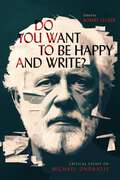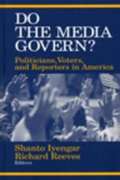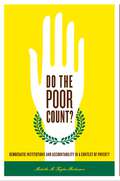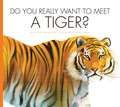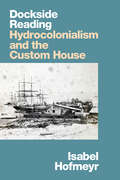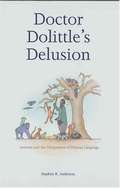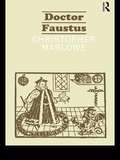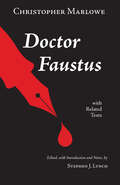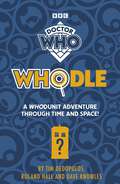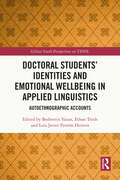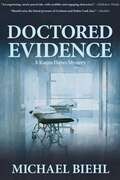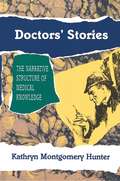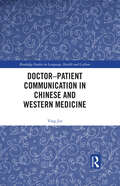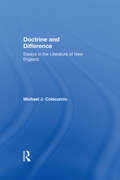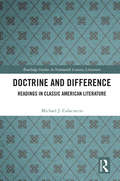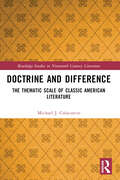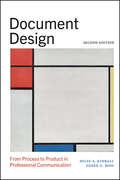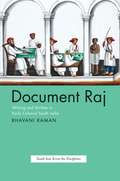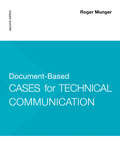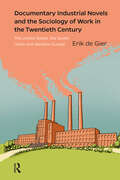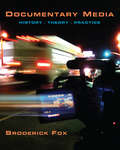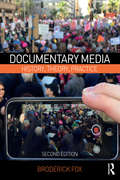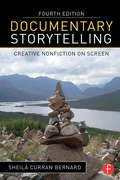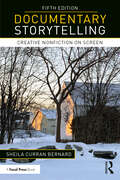- Table View
- List View
Do You Want to Be Happy and Write?: Critical Essays on Michael Ondaatje
by Robert LeckerMichael Ondaatje has achieved international prominence and recognition in a way that few other writers have, let alone Canadian writers. This popularity is most pronounced for works of historical fiction such as The English Patient, winner of the Golden Man Booker Prize, and In the Skin of a Lion, set in 1930s Toronto, shortlisted for the Governor General’s Award and winner of the Canada Reads competition in 2002. But Ondaatje has been writing for over fifty years, and his innovative works include some of the most accomplished poetry in the English-speaking world.Taking its title from a question in his poem “Tin Roof,” Do You Want to Be Happy and Write? reassesses Ondaatje’s writing and the role of the poet, from his troubled explorations of the self-reflexive artist to his most recent novels. Comprehensive in both approach and coverage, this new collection offers groundbreaking analysis informed by an understanding of Ondaatje’s entire oeuvre, placing early poetry collections like The Collected Works of Billy the Kid and There’s a Trick with a Knife I’m Learning to Do alongside the full range of his novels and his extensive work as a literary editor. The book highlights the transnational, postcolonial, and diasporic issues that have become increasingly apparent in Ondaatje’s work. Contributors explore key interests that have reappeared and been rethought across his fiction and poetry: the construction of identity; the nature of memory and its relation to family origins and history; the human body as a site of contestation and struggle; the contrast between Eastern and Western values and the Southeast Asian diaspora; the writer’s responsibility in depictions of war, psychic trauma, and genocide; and an ongoing fascination with the visual and the media of photography and film.An eclectic celebration of an iconic author, Do You Want to Be Happy and Write? offers an authoritative reference point for scholars and students of literature and reveals new facets of a major author to his readers around the world.
Do the Americas Have a Common Literature?
by Gustavo Pérez FirmatThis volume takes an important step toward the discovery of a common critical heritage that joins the diverse literatures of North America and Latin America. Traditionally, literary criticism has treated the literature of the Americas as "New World" literature, examining it in relation to its "Old World"--usually European--counterparts. This collection of essays redirects the Eurocentric focus of earlier scholarship and identifies a distinctive pan-American consciousness.The essays here place the literature of the Americas in a hemispheric context by drawing on approaches derived from various schools of contemporary critical thought--Marxism, feminism, culture studies, semiotics, reception aesthetics, and poststructuralism. As part of their search for a distinctly New World literary idiom, the contributors engage not only the major North American and Spanish American writers, but also such "marginal" or "minor" literatures as Chicano, African American, Brazilian, and Québecois. In identifying areas of agreement and confluence, this work lays the groundwork for finding historical, ideological, and cultural homogeneity in the imaginative writing of the Americas.Contributors. Lois Parkinson Zamora, David T. Haberly, José David Saldívar, Antonio Benítez-Rojo, José Piedra, Doris Sommer, Enrico Mario Santí, Eduardo González, John Irwin, Wendy B. Faris, René Prieto, Jonathan Monroe, Gustavo Pérez Firmat
Do the Media Govern? Politicians, Voters, and Reporters in America
by Richard Reeves Shanto IyengarEssays.
Do the Poor Count?: Democratic Institutions and Accountability in a Context of Poverty (G - Reference, Information and Interdisciplinary Subjects)
by Michelle M. Taylor-RobinsonLatin America’s flirtation with neoliberal economic restructuring in the 1980s and 1990s (the so-called Washington Consensus strategy) had the effect of increasing income inequality throughout the region. The aim of this economic policy was in part to create the conditions for stable democracy by ensuring efficient economic use of resources, both human and capital, but the widening gap between rich and poor threatened to undermine political stability. At the heart of the dilemma faced by these new democracies is the question of accountability: Are all citizens equally capable of holding the government accountable if it does not represent their interests? In this book, Michelle Taylor-Robinson investigates both the formal institutions of democracy (such as electoral rules and the design of the legislative and executive branches) and informal institutions (such as the nomination procedures of political parties and patron-client relationships) to see what incentives legislators have to pay attention to the needs of poor people and thereby adequately represent their interests.
Do you Really Want to Meet A Tiger
by Cari MeisterA child goes on an adventure to Russia as a junior researcher to study tigers in the wild, and learns about this endangered species.
Dockside Reading: Hydrocolonialism and the Custom House
by Isabel HofmeyrIn Dockside Reading Isabel Hofmeyr traces the relationships among print culture, colonialism, and the ocean through the institution of the British colonial Custom House. During the late nineteenth and early twentieth centuries, dockside customs officials would leaf through publications looking for obscenity, politically objectionable materials, or reprints of British copyrighted works, often dumping these condemned goods into the water. These practices, echoing other colonial imaginaries of the ocean as a space for erasing incriminating evidence of the violence of empire, informed later censorship regimes under apartheid in South Africa. By tracking printed matter from ship to shore, Hofmeyr shows how literary institutions like copyright and censorship were shaped by colonial control of coastal waters. Set in the environmental context of the colonial port city, Dockside Reading explores how imperialism colonizes water. Hofmeyr examines this theme through the concept of hydrocolonialism, which puts together land and sea, empire and environment.
Doctor Dolittle’s Delusion: Animals and the Uniqueness of Human Language
by Stephen R. AndersonCan animals be taught a human language and use it to communicate? Or is human language unique to human beings, just as many complex behaviors of other species are uniquely theirs? This engrossing book explores communication and cognition in animals and humans from a linguistic point of view and asserts that animals are not capable of acquiring or using human language. Stephen R. Anderson explains what is meant by communication, the difference between communication and language, and the essential characteristics of language. Next he examines a variety of animal communication systems, including bee dances, frog vocalizations, bird songs, and alarm calls and other vocal, gestural, and olfactory communication among primates. Anderson then compares these to human language, including signed languages used by the deaf. Arguing that attempts to teach human languages or their equivalents to the great apes have not succeeded in demonstrating linguistic abilities in nonhuman species, he concludes that animal communication systems--intriguing and varied though they may be--do not include all the essential properties of human language. Animals can communicate, but they can't talk.
Doctor Faustus: Playscript (More For Teens Ser.)
by Christopher MarloweIn this classic and much-loved edition of Marlowe's best-known play, John D. Jump provides the reader with a wealth of introductory and explanatory material. As well as a fascinating chronology of Marlowe's life and works and extensive notes on the text, this edition includes a substantial and authoritative historical introduction to the play. An essential text whether studying the play in detail or coming to it for the first time.
Doctor Faustus: With Related Texts
by Christopher MarloweThis new edition of Christopher Marlowe&’s Doctor Faustus offers the complete 1604 A-text with embedded selections from the 1616 B-text. Its innovative format will make it easier for readers to note differences between these texts and to consider what is gained and lost in viewing them both separately and together. A full Introduction to the play, notes, and a rich selection of related texts further enhance the value of this edition to students of Renaissance drama, Reformation theology, magic, and occult philosophy.
Doctor Who: Whodle (Doctor Who)
by Doctor Who Roland HallJoin your favourite Time Lord (every one of them!) as a whole host of puzzling mysteries await . . .Which of three possible substances would make the best weapon against a Dalek?How can you tell which mannequin is an Auton?Where in the universe is the Master hiding?Travel through space and time, and across worlds, ships and space stations, as you crack clues, make deductions and solve cases.Using your puzzling powers of logic (plus maybe a sonic screwdriver and some physic paper), it’s down to YOU to help the Doctor and their companions fight monsters and save the day.
Doctoral Students’ Identities and Emotional Wellbeing in Applied Linguistics: Autoethnographic Accounts (Global South Perspectives on TESOL)
by Bedrettin Yazan Ethan Trinh Herrera, Luis Javier PentónThis edited volume comprises an insightful collection of international autoethnographies from doctoral candidates in the field of applied linguistics, narrating and analyzing their student experiences to problematize and challenge the dominant and oppressive cultures of academia. Through 12 select contributions, the book examines the intersection of identity work and emotional labor in the doctoral student journey, sharing insights into the potential of autoethnography for self-reflection, community building, and healing in doctoral studies. Contributors examine their doctoral journeys through personal narratives and testimonials to understand their own experiences, agency, identity, and emotions, encouraging current or former doctoral students to engage in the critical reflection of their own experiences. Chapters are divided into four themes: interrelating multiple identities, navigating and negotiating in-betweenness, engaging emotions and wellbeing, and establishing support systems. Offering unique perspectives from a global spread of PhD candidates, this book will be highly relevant reading for researchers and prospective or current doctoral students of applied linguistics, language education, TESOL, and LOTE. It will also be of interest to those interested in higher education, dissertation research and autoethnography as a method.
Doctored Evidence
by Michael BiehlA mystery novel in the Karen Hayes series previously published in hardcover by Bridgeworks, now in paperback.In the third book of the Karen Hayes series, an elderly nursing home resident, who was once an Olympic champion swimmer with a murky background in the German army, drowns in a lake behind the home. Does anyone know how it happened? Does anyone care? Hospital attorney Karen Hayes battles bureaucracy, listens to the geriatric residents ignored by the authorities, and risks her own life to find the truth.
Doctors' Stories: The Narrative Structure of Medical Knowledge
by Kathryn Montgomery HunterA patient's job is to tell the physician what hurts, and the physician's job is to fix it. But how does the physician know what is wrong? What becomes of the patient's story when the patient becomes a case? Addressing readers on both sides of the patient-physician encounter, Kathryn Hunter looks at medicine as an art that relies heavily on telling and interpreting a story--the patient's story of illness and its symptoms.
Doctor–patient Communication in Chinese and Western Medicine (Routledge Studies in Language, Health and Culture)
by Ying JinDrawing on naturally occurring doctor– patient conversations in real- life medical consultations, this book analyzes the similarities and differences in doctor– patient communication and patient satisfaction between traditional Chinese medicine (TCM) and Western medicine (WM) practiced in China. Little research is available looking at WM being practiced in Asian countries, and misunderstanding about Eastern medicines such as TCM can result in unwarranted claims and suspicions. This volume contributes to research on doctor– patient communication by exploring the communication behaviors between doctors and older patients who are able to communicate independently in both TCM and WM practiced in mainland China and evaluating patient satisfaction with their medical experiences. The book reports findings and insights from three independent and methodologically diverse studies, drawing on data from 69 real- life medical consultations: 30 from TCM and 39 from WM. Using conversation analysis, the Roter Interaction Analysis System, and both quantitative and qualitative methods, Ying Jin examines the differences between TCM and WM to help reveal the dynamics of doctor– patient interactions, the contextual details, and the impact of the clinical culture on medical communication. This insightful book will appeal to scholars and students from linguistics, language, and health communication as well as medical practitioners interested in doctor– patient communication and intercultural communication. The findings reported here will shine a light on the relationship between clinical differences, health communication, and patient outcomes.
Doctrine and Difference: Essays in the Literature of New England (Routledge Studies In Nineteenth Century Literature Ser. #2)
by Michael J. ColacurcioFirst published in 1997. Routledge is an imprint of Taylor & Francis, an informa company.
Doctrine and Difference: Readings in Classic American Literature (Routledge Studies in Nineteenth Century Literature #2)
by Michael J. ColacurcioDoctrine and Difference: Readings in Classic American Literature aims to expand and deepen the inquiry begun in the volume from 2007. Beginning with an essay on the avowedly Puritan poetry of Anne Bradstreet and ending with two not-quite-secular novels from late in the 19th century, this volume seeks to uncover the religious and philosophical meanings deeply embedded in so much of 19th century American literature, and then, importantly, to identify and analyze the techniques by which the "doctrines" are differentiated into imaginative literature. Poe, Emerson, Thoreau, Hawthorne, Melville—and yes, even Howells and James—are driven by powerful thematic intentions. But they do not preach: they dramatize. And, as they talk their way through their existential issues, they often talk to one another: yes, no, maybe, ok but not so fast. Stressing the idea of a shared, poet-Puritan inheritance, the new Doctrine and Difference means to re-confirm the vitality of literary history and, in particular, the importance of reading the classic texts of American literature in context and in relation.
Doctrine and Difference: The Thematic Scale of Classic American Literature (Routledge Studies in Nineteenth Century Literature)
by Michael J. ColacurcioDoctrine and Difference: The Thematic Scale of Classic American Literature aims to expand and deepen our knowledge into the inquiry of “contextual historicism,” observing writers of the American nineteenth century, and their vastly differing approaches to perceptions such as race, gender, and national identity. Ranging from the religious acuities of the first American Puritans to the more secularized literary awakening of the American Renaissance and into late-century texts that deliberately resist the limits of received religious and political opinion, this volume seeks to uncover a history of human thought within classic American Literature. This volume critically observes these survivable works of literature, presenting insight into the “difference” made by conversation, dispute, and dramatized self-doubt within novels and poems of the historical past.
Document Design: From Process to Product in Professional Communication (SUNY series, Studies in Technical Communication)
by Miles A. Kimball Derek G. RossIntroduces students to the basic principles and theories of design, combining practical advice about the design process with a foundation in visual rhetoric and usability.Document Design introduces students to the basic principles and theories of design, combining practical advice about the design process with a foundation in visual rhetoric and usability. Most books on document design lean toward either theory or practice. This book offers a balanced approach-theoretically informed practice-that introduces a working vocabulary to help students become reflective practitioners, able not only to create effective designs but also to explain why and how they made their design choices. Derek G. Ross and Miles A. Kimball hope to give students the foundation they need to make design decisions in any rhetorical situation. Students will learn to negotiate between the needs of both users and clients to consider the nuances of audience, purpose, and context.
Document Raj: Writing and Scribes in Early Colonial South India
by Bhavani RamanHistorians of British colonial rule in India have noted both the place of military might and the imposition of new cultural categories in the making of Empire, but Bhavani Raman, in "Document Raj," uncovers a lesser-known story of power: the power of bureaucracy. Drawing on extensive archival research in the files of the East India CompanyOCOs administrative offices in Madras, she tells the story of a bureaucracy gone awry in a fever of documentation practices that grew ever more abstractOCoand the power, both economic and cultural, this created. aIn order to assert its legitimacy and value within the British Empire, the East India Company was diligent about record keeping. Raman shows, however, that the sheer volume of their document production allowed colonial managers to subtly but substantively manipulate records for their own ends, increasingly drawing the real and the recorded further apart. While this administrative sleight of hand increased the companyOCOs reach and power within the Empire, it also bolstered profoundly new orientations to language, writing, memory, and pedagogy for the officers and Indian subordinates involved. Immersed in a subterranean world of delinquent scribes, translators, village accountants, and entrepreneurial fixers, "Document Raj" maps the shifting boundaries of the legible and illegible, the legal and illegitimate, that would usher India into the modern world.
Document-Based Cases for Technical Communication
by Roger MungerWith seven context-rich scenarios and more than 50 sample documents to analyze, revise, and design, this booklet offers students realistic opportunities to practice writing in the workplace. The new edition features a fresh new design and new cases and writing tasks that incorporate online genres and social media tools. A companion Web site provides digital versions of all the documents in the book for students to download and work with as well as new scoring guides for instructors.
Documentary Industrial Novels and the Sociology of Work in the Twentieth Century: The United States, the Soviet Union and Western Europe
by Erik GierIn several European countries, the United States, and the Soviet Union, remarkable industrial novels based on empirical observations were written between 1900 and 1970. With two successive world wars and the rise of communism and fascism, this was an exceptionally turbulent time in the history of industrial capitalism as Taylorism and Fordism sought to increase production and consumption. This social landscape shaped modernist industrial novels. Key themes in these novels were class conflict, bad working conditions, worker alienation, changing workmen and employee cultures, urbanization, and worker migration. The primary goal was to document and publicize the real developments of working conditions in factories and offices, often aiming to influence both company welfare work and state social policies. This book focuses on the modernist industrial novel as written in five large industrial nations: the United States before WWII, the Stalinist Soviet Union, Weimar Germany, post-WWII Italy, and France.
Documentary Media: History, Theory Practice, CourseSmart eTextbook
by Broderick FoxDocumentary Media: History, Theory, Practice facilitates the study of documentary media, its changing forms, and diverse social functions. Fox provides balanced and accessible coverage of the historical, critical, and the practical aspects of documentary media without mandating specialized skills sets in students or access to costly technology. For practitioners and students alike, Documentary Media lays out fundamental concepts and production processes needed to contribute to the contemporary production of non-fiction media in the digital age. Each chapter engages students by challenging traditional assumptions about documentary form and function, posing critical and creative questions, and offering historical and contemporary examples. Additionally, each chapter closes with an "Into Practice" section that assists readers in applying the chapter's concepts. Fox aims to help the student establish a complete treatment, aesthetic plan, and pre-production strategy for their own documentary project.
Documentary Media: History, Theory, Practice
by Broderick FoxIn a digital moment where both the democratizing and totalitarian possibilities of media are unprecedented, the need for complex, ethical, and imaginative documentary media—for you, the reader of this book to think, question, and create—is vital. Whether you are an aspiring or seasoned practitioner, an activist or community leader, a student or scholar, or simply a curious audience member, author Broderick Fox opens up documentary media, its changing forms, and diversifying social functions to readers in a manner that is at once rigorous, absorbing, and practical. This new edition updates and further explores the various histories, ideas, and cultural debates that surround and shape documentary practice today. Each chapter engages readers by challenging traditional assumptions, posing critical and creative questions, and offering up innovative historical and contemporary examples. Additionally, each chapter closes with an "Into Practice" section that provides analysis and development exercises and hands-on projects that will assist you in generating a full project prospectus, promotional trailer, and web presence for your own documentary.
Documentary Storytelling: Creative Nonfiction on Screen
by Sheila Curran BernardDocumentary Storytelling has reached filmmakers and filmgoers worldwide with its unique focus on the key ingredient for success in the growing global documentary marketplace: storytelling. This practical guide reveals how today's top filmmakers bring the tools of narrative cinema to the world of nonfiction film and video without sacrificing the rigor and truthfulness that give documentaries their power. The book offers practical advice for producers, directors, editors, cinematographers, writers and others seeking to make ethical and effective films that merge the strengths of visual and aural media with the power of narrative storytelling. In this new, updated edition, Emmy Award-winning author Sheila Curran Bernard offers: New strategies for analyzing documentary work New conversations with filmmakers including Stanley Nelson (The Black Panthers), Kazuhiro Soda (Mental), Orlando von Einsiedel (Virunga), and Cara Mertes (JustFilms) Discussions previously held with Susan Kim (Imaginary Witness), Deborah Scranton (The War Tapes), Alex Gibney (Taxi to the Dark Side), and James Marsh (Man on Wire).
Documentary Storytelling: Creative Nonfiction on Screen
by Sheila Curran BernardFor nearly two decades, Documentary Storytelling has reached filmmakers and filmgoers worldwide with its unique focus on the key ingredient for success in the global documentary marketplace: storytelling. As this revised, updated fifth edition makes clear, nonfiction storytelling is not limited to character-driven journeys, but instead encompasses the diverse ways in which today’s top documentarians reach audiences with content that is creative, original, and often inspirational, all without sacrificing the integrity that gives documentary its power. This book is filled with practical advice for writers, producers, directors, editors, cinematographers, and others committed to reality-based filmmaking that seeks to reach audiences, raise awareness, address social issues, illuminate the human condition, and even entertain. In this new edition, Emmy Award-winning filmmaker and author Sheila Curran Bernard offers: a closer look at the way ethical nonfiction filmmakers take creative, authorial leaps while also remaining transparent with audiences; new tools for understanding how documentaries are structured, how they may rearrange time for storytelling effect, and how a simple narrative throughline can convey complexity without being a conventional "hero’s journey"; new conversations with filmmakers and educators including Dawn Porter, Madison Hamburg, Tracy Heather Strain, June Cross, Heidi Gronauer, and Julie Casper Roth, and another look at conversations with Stanley Nelson and Orlando von Einsiedel. Please visit the book’s website, available at www.documentarystorytelling.com, for further information, related articles, and more.
